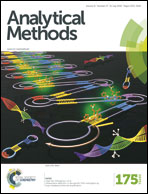Simultaneous determination of lead and tin at the bismuth film electrode by square wave stripping voltammetry and chemometric methods†
Abstract
The voltammograms of lead and tin are strongly overlapped due to their similar properties in electroanalysis, making it difficult for the individual quantification of each analyte. A square wave anodic stripping voltammetry (SWASV) method for the simultaneous determination of the two metals at the bismuth film electrode (BiFE) was proposed. The experimental conditions were investigated and optimized. The linear dynamic ranges and limits of detection (LODs) were determined to be 4–150 μg L−1 and 1.13 μg L−1 for lead, and 4–110 μg L−1 and 0.74 μg L−1 for tin. Radial basis function artificial neural network (RBF-ANN) was introduced to solve the resolution problem, and its performance was compared with the conventional chemometric methods including principal component regression (PCR), partial least squares (PLS) and least-squares support vector machines (LS-SVM). By analyzing a set of synthetic mixtures of the two metals with the proposed methods, the lowest root-mean-square error of calibration (RMSEC) and root-mean-square error of prediction (RMSEP) were achieved with RBF-ANN and the method was applied to real tap water samples spiked with known amounts of lead and tin with satisfactory recoveries of 105% and 102%, respectively. Therefore, it is concluded that SWASV coupled with RBF-ANN is an effective alternative for the simultaneous determination of lead and tin.


 Please wait while we load your content...
Please wait while we load your content...